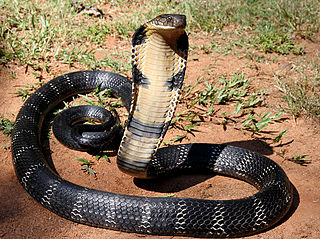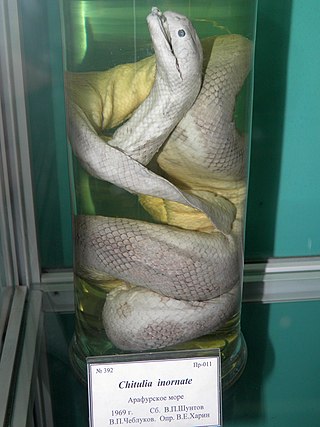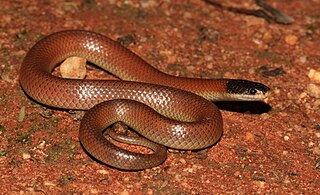
Elapidae is a family of snakes characterized by their permanently erect fangs at the front of the mouth. Most elapids are venomous, with the exception of the genus Emydocephalus. Many members of this family exhibit a threat display of rearing upwards while spreading out a neck flap. Elapids are endemic to tropical and subtropical regions around the world, with terrestrial forms in Asia, Australia, Africa, and the Americas and marine forms in the Pacific and Indian Oceans. Members of the family have a wide range of sizes, from the 18 cm (7.1 in) white-lipped snake to the 5.85 m king cobra. Most species have neurotoxic venom which is channeled by their hollow fangs, and some may contain other toxic components in various proportions. The family includes 55 genera with some 360 species and over 170 subspecies.

Acanthophis is a genus of elapid snakes. Commonly called death adders, they are native to Australia, New Guinea and nearby islands, and are among the most venomous snakes in the world. Despite their common name, they are not adders at all and belong to the Elapidae family. The name of the genus derives from the Ancient Greek akanthos/ἄκανθος ('spine') and ophis/ὄφις ('snake'), referring to the spine on the death adder's tail.

The eastern brown snake, often referred to as the common brown snake, is a species of highly venomous snake in the family Elapidae. The species is native to eastern and central Australia and southern New Guinea. It was first described by André Marie Constant Duméril, Gabriel Bibron, and Auguste Duméril in 1854. The adult eastern brown snake has a slender build and can grow to 2 m (7 ft) in length. The colour of its surface ranges from pale brown to black, while its underside is pale cream-yellow, often with orange or grey splotches. The eastern brown snake is found in most habitats except dense forests, often in farmland and on the outskirts of urban areas, as such places are populated by its main prey, the house mouse. The species is oviparous. The International Union for Conservation of Nature classifies the snake as a least-concern species, though its status in New Guinea is unclear.

Stokes's sea snake is a large species of sea snake in the family Elapidae. It is sometimes placed in its own genus Astrotia. The species is endemic to tropical Indo-Pacific oceanic waters.

Hydrophis inornatus, commonly known as the plain sea snake, is a species of venomous sea snake in the family Elapidae.

The spine-bellied sea snake, also commonly known as Hardwicke's sea snake and Hardwicke's spine-bellied sea snake, is a species of venomous sea snake in the family Elapidae.

Pseudonaja is a genus of highly venomous elapid snakes native to Australia. Species of this genus are known commonly as brown snakes and are considered to be some of the most dangerous snakes in the world; even young snakes are capable of delivering a fatal envenomation to a human.
Drysdalia is a genus of snakes, commonly known as crowned snakes, belonging to the family Elapidae. The three species in this genus are venomous snakes, but not considered deadly.

Pseudechis is a genus of venomous snakes in the family Elapidae. It contains the group of elapid species commonly referred to as the black snakes. Species of Pseudechis are found in every Australian state with the exception of Tasmania, and some species are found in Papua New Guinea. They inhabit a variety of habitat types, from arid areas to swampland. All species are dangerous and can inflict a potentially lethal bite. Most snakes in this genus reach about 2 m (6.6 ft) in total length, and vary in colour. Some species are brown, whereas others are black. The most recognisable and widespread species in the genus are the red-bellied black snake and the mulga snake. These snakes feed on lizards, frogs, birds, small mammals, and even other snakes. All species of Pseudechis lay eggs with the exception of the red-bellied black snake P. porphyriacus which is viviparous. The genus Pailsus is a synonym of Pseudechis, and more work is needed to understand species limits among the smaller species of the group.

The white-lipped snake is a small species of venomous snake in the family Elapidae. The species is endemic to south-eastern mainland Australia and Tasmania.

The short-nosed snake is a species of venomous snake in the family Elapidae. The species is endemic to Australia. Short-nosed snakes are endemic to swamplands and coastlands in the southwest of Western Australia, where they shelter in nests of stick ants, as well as dense rushes and reed tussocks. Short-nosed snakes are known to prey on small skinks mainly from the skink genus hemiergis, and small species of frogs.

Dwyer's snake also known commonly as the whip snake and the variable black-naped snake, is a species of venomous snake in the family Elapidae. The species is endemic to Australia, where it is found from New South Wales to South Queensland. While closely related to Australian sea snakes, S. dwyeri is a terrestrial reptile.
The spotted mulga snake, also known commonly as Butler's black snake and Butler's snake, is a species of venomous snake in the family Elapidae. The species is endemic to Western Australia. It is a member of the genus Pseudechis, dangerously venomous snakes that can intimidate an opponent by raising the head and presenting a hood. This cobra-like threat display is supported by the ability to produce a very large amount of venom.

The bandy-bandy, also commonly known as the hoop snake, is a species of venomous snake in the family Elapidae. The word bandy-bandy (bandi-bandi) traces back to the indigenous dialect of Kattang, from the Taree region, New South Wales. There are 5 known species of bandy-bandy, all of which are endemic to Australia.

Demansia is a genus of venomous snakes of the family Elapidae. Members of the genus are commonly known as whip snakes or whipsnakes, as are members of several other genera.
The Pilbara death adder, also known commonly as Wells' death adder, is a species of venomous snake in the family Elapidae. The species is one of the eight members of the genus Acanthophis, a genus which is found throughout northwestern and southwestern Australia and some parts of southern Papua New Guinea. The species Acanthophis wellsi is endemic to Western Australia.

The Mallee black-backed snake, also known commonly as the black-backed snake, the copper snake, and Mitchell's short-tailed snake, is a species of venomous snake in the family Elapidae. The species is endemic to Australia.
The Pilbara bandy bandy is a species of venomous snake in the family Elapidae. The species is endemic to Australia.
The Weipa bandy bandy is a species of snake in the family Elapidae, described in 2018.
Brachyurophis incinctus is a species of snake from the family Elapidae, commonly named the unbanded shovel-nosed snake, and is a species endemic to Australia. Its common name reflects its shovel nose specialisation, burrowing behaviour and the fact that it is not banded on its body.














